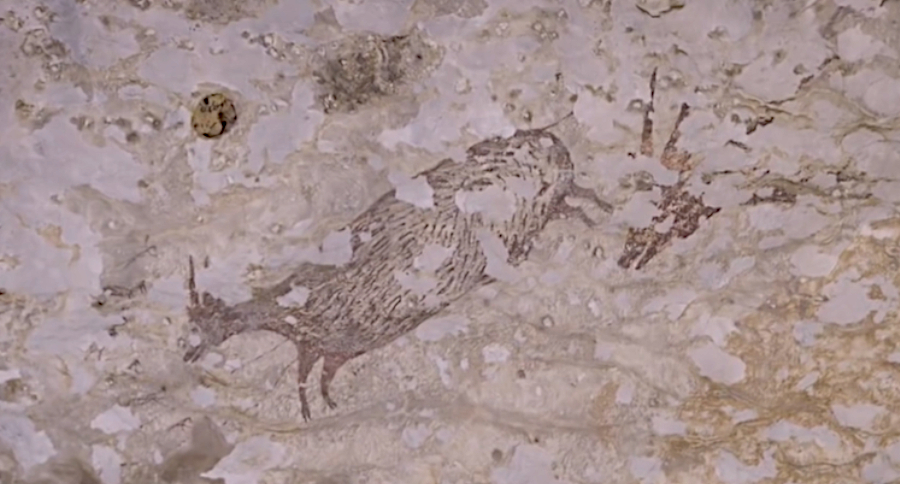A cave art hunting scene found on an Indonesian Island may be the oldest piece of storytelling art ever.
Ever since humans first learned how to hunt, we have been fascinated with documenting our hunts and sharing the tales from our pursuit of wild animals. Ancient humans often documented the animals they hunted in cave paintings.
You've probably heard of Lascaux cave in southwestern France. It's one of the most famous pieces of prehistoric art in the world. The cave walls are adorned with hundreds of human figures and depictions of animal figures of the time. It's extremely old too, at nearly 17,000 years.
But a new piece of ancient art discovered in 2017 in Indonesia on the Island of Sulawesi blows Lascaux out of the water age-wise. Archaeologists say this new painted cave discovery contains some of the oldest cave paintings in existence. Early humans created the scene a jaw-dropping 43,900 years old, according to Fox News.
Science News reports the minimum age for the paintings is likely 35,100 years, which is still impressively old. The estimated date range does put the paintings amongst some other impressively old sites in Indonesia, but also sites in Europe such as Chauvet Cave in France and El Castillo Cave in Spain.
Researchers believe these new paintings weren't created by primitive neanderthals, but instead were crafted with more developed human hands.
"We assume these ancient artists were Homo sapiens and that spirituality and religious thinking were part of early human culture in Indonesia," archaeologist Adam Brumm told Science News.
Brumm and another archaeologist, Maxime Aubert led a team studying the paintings, which cover an area roughly 14 feet across according to Science News. The painting depicts pigs and anoa, which is also know as the "midget buffalo" in Indonesia.
The scene also features some human-like figures and other paintings the researchers believe are human-animal hybrids. There is also at least one hand stencil created by the ancient artist holding a hand against the wall and then spraying the paint or pigment over their hand.
The researchers published an extensive report on the paintings on Nature.com. What's interesting about the report is they believe the paintings aren't just images slapped on a random wall. "Although the meanings of the imagery are uncertain and likely to remain so, this rock art scene may be regarded not only as the earliest dated figurative art the world, but also as the oldest evidence for the communication of a narrative in Paleolithic art," their study reads.
This is important because it could teach the scientists much about how the brains of modern humans developed. "This is noteworthy, given that the ability to invent fictional stories may have been the last and most crucial stage in the evolutionary history of human language and the development of modern-like patterns of cognition," the study reads.
It really is fascinating stuff. As modern hunters, we just also appreciate the glimpse into the look at how our ancient ancestors lived and gathered their food.
It just goes to show that a good hunting story truly is timeless.
For more outdoor content from Travis Smola, be sure to follow him on Twitter and check out his Geocaching and Outdoors with Travis Youtube channels.
NEXT: TEXAS IS STILL LOSING THE WAR ON FERAL HOGS
WATCH




